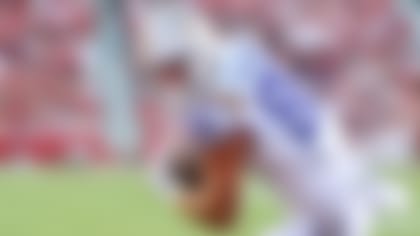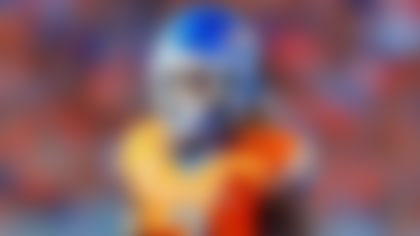Robert Griffin III's highly anticipated return at the outset of this season was supposed to trigger an inspired NFC East title defense from the Washington Redskins. However, the second-year pro has struggled to find his rhythm, and the Redskins' offense has been an overall disappointment as a result, with the team stumbling to a 1-4 start.
While the sky might seem to be falling in Washington, I believe a few encouraging developments could spark a run back to the top of the division.
After closely examining the All-22 Coaches Film of the Redskins' recent games, I found three reasons to believe this team can get right back in the thick of the playoff hunt.
1) RGIII can get back into his comfort zone.
Griffin's quick assimilation into the NFL last season was fueled by coach Mike Shanahan's decision to incorporate a number of spread-offense concepts into the Redskins' playbook. Griffin thrived in a spread-option attack at Baylor; Washington's use of familiar plays and terminology allowed the rookie to play without hesitation in the backfield. Additionally, the heavy reliance on designed quarterback runs allowed Griffin to use his remarkable speed and quickness to make plays on the perimeter.
Some would argue the quarterback runs left Griffin exposed, ultimately leading to the knee injury that knocked him out of Washington's playoff loss and required offseason surgery. However, I would counter that taking advantage of Griffin's athleticism on the perimeter is risky only when he refuses to get down or go out of bounds at the end of runs.
Ultimately, the clever use of an athletic quarterback makes it tough for opposing defensive coordinators to craft effective schemes to stop the run or pass. When Griffin is unleashed as a run-pass threat on the perimeter, the Redskins enjoy a tremendous advantage, as evidenced in the video clip on the right, taken from Sunday night's loss to the Dallas Cowboys.
Tape of the Redskins' first few games of 2013 makes it clear the team was easing Griffin back into the lineup by limiting his rushing attempts. Washington rarely used any read-option plays and kept the designed quarterback runs to a minimum. These tactics kept Griffin from taking big hits from opponents. However, the Redskins' offense hasn't been nearly as productive as one would expect the NFL's fourth-ranked unit to be; they're averaging 5.9 yards per play, down from their league-leading average (6.2) of 2012.
Part of the decline can be attributed to the Redskins' inability to generate explosive plays in the passing game (just 11 completions of 20-plus yards in five games). Sure, the running attack has remained effective, notching six runs of 20 yards or more, but it's worth noting that two of those came against the Cowboys, when the Redskins re-introduced the quarterback ground game.
If the Redskins again use their most explosive athlete's legs to force opponents to play honestly in all aspects, they can rediscover the potent offensive formula that keyed their surprising 2012 playoff run.
2) The threat of the QB run can open up bigger lanes for Alfred Morris.
I don't want to diminish Morris' tremendous accomplishments as a rookie runner last season, but he definitely benefitted from playing alongside Griffin. The threat that the explosive quarterback would dart away on read-option and bootleg plays sparked defensive hesitation, creating more space for Morris on the front side. Also, the potential that Griffin would keep the ball on a stretch-bootleg prevented defenders from flying to Morris on the outside bounce play. And because opponents had to commit at least one defender to respect Griffin, Morris rarely faced a loaded box.
This season, however, with Griffin running less, opponents have been able to focus more on stopping Morris on cutback runs. Backside defensive ends and linebackers have been able to fly faster to the ball. Of course, a tendency to fall behind quickly also has impacted Washington's game plan and play-calling tendencies, but the fact remains that Griffin's underutilization as a runner (just 18 carries in the team's first four games) has impacted Morris' production and output.
The screengrab below, taken from the Redskins' Week 3 loss to the Detroit Lions, illustrates how the stretch-bootleg combination can produce a big gain.
The Redskins break the huddle in a dubs formation, with Josh Morgan positioned just inside the tight end, following short motion:
After the snap, Griffin hands the ball to Morris on a stretch play to the left before executing a bootleg fake. The fake forces the end to initially step outside to contain the edge and leads the cornerback to pause for a second, to determine if the play is a run or pass:
By the time the defensive end and cornerback realize Morris has the ball, both defenders are out of position and unable to keep the ball inside:
Morris eventually bounces around the corner and scoots untouched for a 30-yard score.
Such plays helped the Redskins finish the 2012 season with the NFL's No. 1 rushing attack. It's imperative that they resume using Griffin's running skills to create better opportunities for Morris at the point of attack.
3) Play-action passes off read-option/bootleg looks can produce big gains.
The Redskins fielded one of the most explosive passing offenses in the NFL last season, even though they rarely put the ball in the air (ranking 30th in the NFL with 442 passing attempts). Some of that production was fueled by their receivers, but much of it can be attributed to the running game and clever scheming that helped create big plays.
Since entering the NFL in 1984, Mike Shanahan has been regarded as one of the top play-callers in the game. One of the staples of his offensive approach has been the stretch-bootleg passing game. In theory, the threat of the stretch running play to the front side forces defenders, particularly linebackers, to fly to the edges to prevent ball carriers from heading there. The offense will take advantage of the second-level defenders vacating their positions by flooding intermediate zones with various crossing routes originating from the play side. Shanahan further tweaks the routes to capitalize on favorable looks in the secondary, leading to big gains.
In the screengrab below, taken from Sunday's matchup with Dallas, the Redskins break the huddle in a duo formation, with Santana Moss aligned in the slot to the right:
On the snap, Griffin fakes the stretch to the left before dropping back. Jordan Reed is running a slide route from his offset position on the left, while Moss is executing a delayed wheel route. The play fake by Griffin lures the Cowboys' second-level defenders -- including slot corner Brandon Carr -- to the line of scrimmage:
The resulting hesitation allows the veteran Moss, who still has the speed to blow past most defenders, to get open downfield for a 26-yard gain.
Another key to the Redskins' explosive passing game in 2012 was the superb use of play-action passes off read-option action. The threat that Griffin would get to the corner on an option play forced opponents to tweak their coverage responsibilities, leaving the defense vulnerable to play-action passes to the perimeter. The Redskins execute these concepts in a variety of ways, but their most effective option is using the bubble screen off the read.
In the screengrab below, taken from the Redskins' Week 2 loss to the Green Bay Packers, the offense breaks the huddle in a trips formation, with running back Roy Helu positioned outside. Prior to the snap, Helu motions into the backfield to give Griffin a possible option as a runner:
After the snap, Griffin fakes a sweep to Helu, who's heading right, before throwing a quick screen to Pierre Garcon on the left:
The defense overreacts to the run fake, and Garcon heads upfield behind a convoy of blockers outnumbering the Packers on the perimeter:
This play results in a 44-yard gain for the Redskins.
With the Redskins reincorporating quarterback runs and the read-option attack into their game plan, expect more explosive plays on play-action passes.
Follow Bucky Brooks on Twitter @BuckyBrooks












